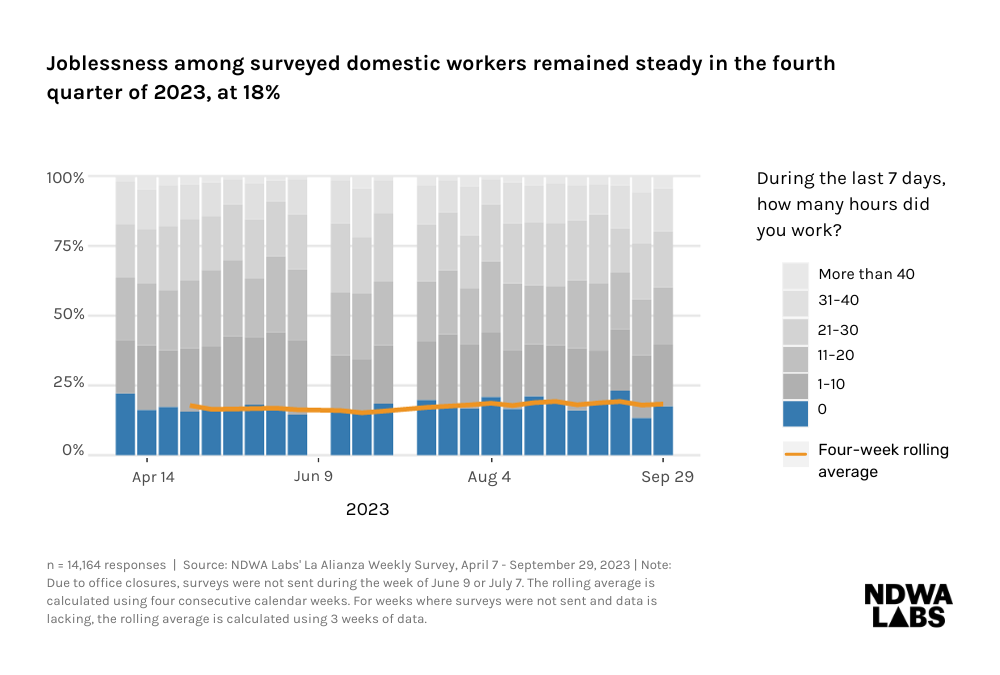JOBLESSNESS AMONG DOMESTIC WORKER RESPONDENTS WAS AT 21% IN DECEMBER
NEARLY SIX IN TEN RESPONDENTS REPORTED FACING DIFFICULTY AFFORDING EXPENSES IN THE FOURTH QUARTER OF 2023
Domestic Workers Economic Situation Report · December 2023
With analysis from the fourth quarter of 2023
Source: La Alianza surveys, NDWA Labs
Released: January 8, 2023
The most recent Bureau of Labor Statistics (BLS) Employment Situation Report shows an increase in nonfarm payroll jobs. The general unemployment rate remained steady compared to November, while the rate for Latina women increased [1].
NDWA Labs’ December data shows that the joblessness rate for domestic worker respondents increased slightly to 21%. It remains higher compared to the rate of 9% who reported having no jobs before COVID-19 [2].
Domestic workers are the nannies, homecare workers, and house cleaners whose work is essential to our economy, yet they are some of the most vulnerable and marginalized workers. They work in private homes and often have multiple employers, meaning they may have to schedule several jobs to make ends meet. Domestic workers earn less than the average US worker and are three times as likely to be living in poverty [3].
La Alianza survey data from Spanish-speaking domestic workers shows how respondents continue to face low wages and high levels of unemployment and underemployment.
December Jobs Report - Bureau of Labor Statistics
The BLS releases an Employment Situation Summary with employment and other labor market data each month. It's an important report to keep track of how the economy is doing. However, domestic workers and other vulnerable workers are underrepresented in official data [4]. Here, we present an overview of the BLS Jobs report along with NDWA Labs’ data, which shows the employment and economic situation of thousands of Spanish-speaking domestic workers.
On January 5, the BLS released new employment data for December 2023.
The number of nonfarm payroll jobs increased.
The general unemployment rate remained steady.
The unemployment rate for Latina women increased.
The unemployment rate for Black women remained the same.
The unemployment rates for Black and Latinx adults continue to be higher compared to the rates for white adults.
The average hourly earnings for private nonfarm payrolls increased.
NDWA Labs’ data similarly shows an uptick in joblessness for surveyed Spanish-speaking domestic workers.
Note: While the share of joblessness for domestic workers is not directly comparable to the unemployment rate nationwide*, looking at trends in the data for Spanish-speaking domestic workers in the context of national trends can support our understanding of the sector as it relates to the broader economy.
December Domestic Worker Economic Situation
Below are the main findings on the economic situation of Spanish-speaking domestic workers in December. Note that monthly numbers may be volatile, which is why we look at the findings as they relate to prior trends in the data and the economic situation of the overall economy. At the end of each quarter, we calculate quarterly averages for key economic indicators.
Note: The survey sample was expanded on September 22 to increase the volume of responses and address survey fatigue. Some of the changes reflected in this report may be due to new respondents facing a different employment situation on average compared to the population that was reflected in our prior reports.
Jobs and Wages
Joblessness remained steady in the fourth quarter, at 18% on average.
21%, 16%, and 18% of domestic worker respondents were jobless on average in the first three quarters of 2023, respectively.
Joblessness in December, the final month of the fourth quarter, increased by 1 percentage point since November, to 21%.
Underemployment increased to 60% in the fourth quarter, with 6 in 10 respondents saying they wanted more work hours than they had.
The main reason for underemployment that workers reported in the fourth quarter was that they could not find more clients (61%), followed by having a health problem (13%) and taking care of a family member (15%), while 11% chose some “other” reason.
Underemployment in December was at 52% on average.
The wage distribution improved during the fourth quarter of 2023 and throughout the year, 56% of domestic worker respondents reported earning less than $15 per hour on average, compared to 63%, 62%, and 58% during the first, second, and third quarters, respectively.
The gap with the wage distribution before COVID is closing. The share of respondents who earned less than $15 per hour before COVID-19 was at most 55%.**
In the fourth quarter of 2023, 14% of workers earned $9 or less per hour, 42% earned $10-14, and 44% earned $15 or more per hour on average.
In December, 59% of respondents reported earning less than $15 per hour on average, the same as in November.
Economic Security
In the fourth quarter of 2023, 82% of domestic worker respondents said their households faced food scarcity, a 1 percentage point increase from the prior quarter.
In the fourth quarter, respondents said they either often (12%) or sometimes (70%) faced food scarcity the week before being surveyed.
Food scarcity in December decreased by 5 percentage points since November, to 79%.
Surveyed domestic workers’ housing insecurity decreased by 2 percentage points in the fourth quarter of 2023 to 48%.
On average, 49%, 46%, and 50% of domestic worker respondents reported being unable to pay their monthly rent or mortgage at the beginning of the month during the first, second, and third quarters, respectively.
7% percent of respondents reported that the question regarding the ability to afford rent or mortgage did not apply to them in the third quarter. This does not necessarily mean they are housing secure. While some of these respondents may be debt-free homeowners, others may be temporarily staying with friends or family, staying in shelters, or facing homelessness.
The share of respondents who could not afford their rent or mortgage remained the same in December as in November, at 47%.
The share of domestic worker respondents who struggled to afford regular household expenses increased in the fourth quarter of 2023.
On average during the fourth quarter, 55% of respondents reported it was very or somewhat difficult to afford regular household expenses- such as food, housing, car payments, and medical expenses. This question is asked once a month.
For comparison, 51%, 47%, and 47% of respondents reported difficulty during the first, second, and third quarters respectively.
Looking at monthly changes, the share increased in December by 4 percentage points, to 58%.
About the surveys
NDWA Labs surveys Spanish-speaking domestic workers each week, via La Alianza, a Messenger chatbot. At the end of each survey, La Alianza provides respondents with relevant news articles and resources in Spanish. To learn more about NDWA Labs’ La Alianza survey of Spanish-speaking domestic workers, see the methodology section of this report.
In September 2023, the survey sample was expanded to increase the volume of responses and address survey fatigue. We learned that respondents newly added to the survey schedule reported lower joblessness on average compared to prior respondents. To avoid monthly volatility going forward, we will update the rotation groups in 2024 to ensure a comparable share of “new” and “prior” respondents each week.
The employment numbers presented in this report include data from ten weekly surveys in the fourth quarter of 2023. The total number of fully completed surveys in the fourth quarter, which includes both new and repeated respondents, was 12,597. For greater detail on completions broken down by month, please see the table below. Surveys were paused for the remainder of 2023 after December 15 due to NDWA’s winter office closure.
| Month | Number of weekly surveys | Total completed surveys |
|---|---|---|
| December | 2 | 2,206 |
| November | 4 | 6,568 |
| October | 4 | 3,823 |
Questions about hours worked and hourly wages are asked weekly, questions regarding underemployment and job search are asked bi-weekly, and questions about economic security are asked monthly.
For questions or feedback, please contact us here.
Notes
1 White House Council of Economic Advisers (2024), A Strong Year for the Labor Market
2 NDWA Labs (2020), 6 Months in Crisis: The Impact of COVID-19 on Domestic Workers
3 Economic Policy Institute (2022), Domestic Workers Chartbook
4 Kopparam (2022), What federal statistical agencies can do to improve survey response rates among Hispanic communities in the United States
* Unlike unemployment rates, joblessness for domestic workers may include people who are not working but are currently unavailable to work, or not actively looking for jobs. Additionally, the NDWA Labs’ joblessness rate for surveyed domestic workers is not seasonally adjusted, while BLS unemployment rates are adjusted.
** The share of respondents earning less than $15 in 2022 cannot be directly compared to baseline numbers before COVID-19, due to a change in answer option ranges. However, since 55% of respondents reported earning $15 or less before COVID-19 [2], a share which is inclusive of those who earned $15 per hour, we know that the share of respondents earning less than $15 is at most 55%.



